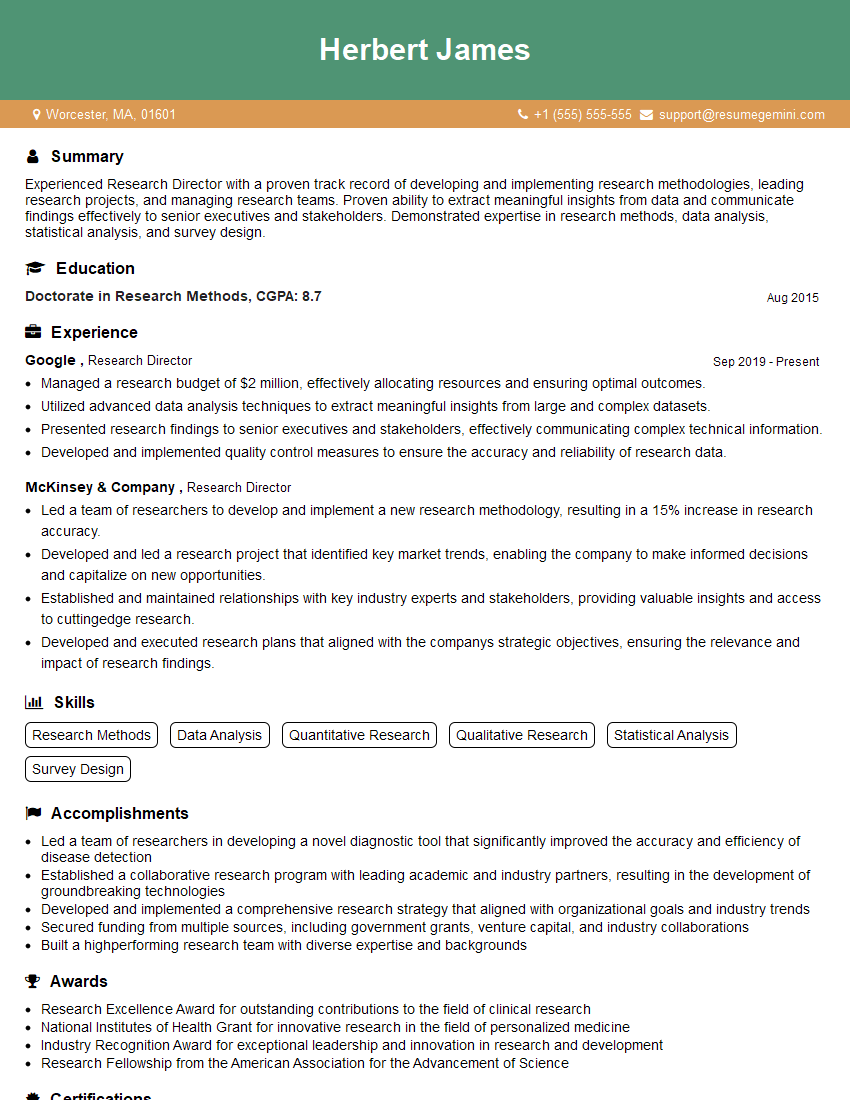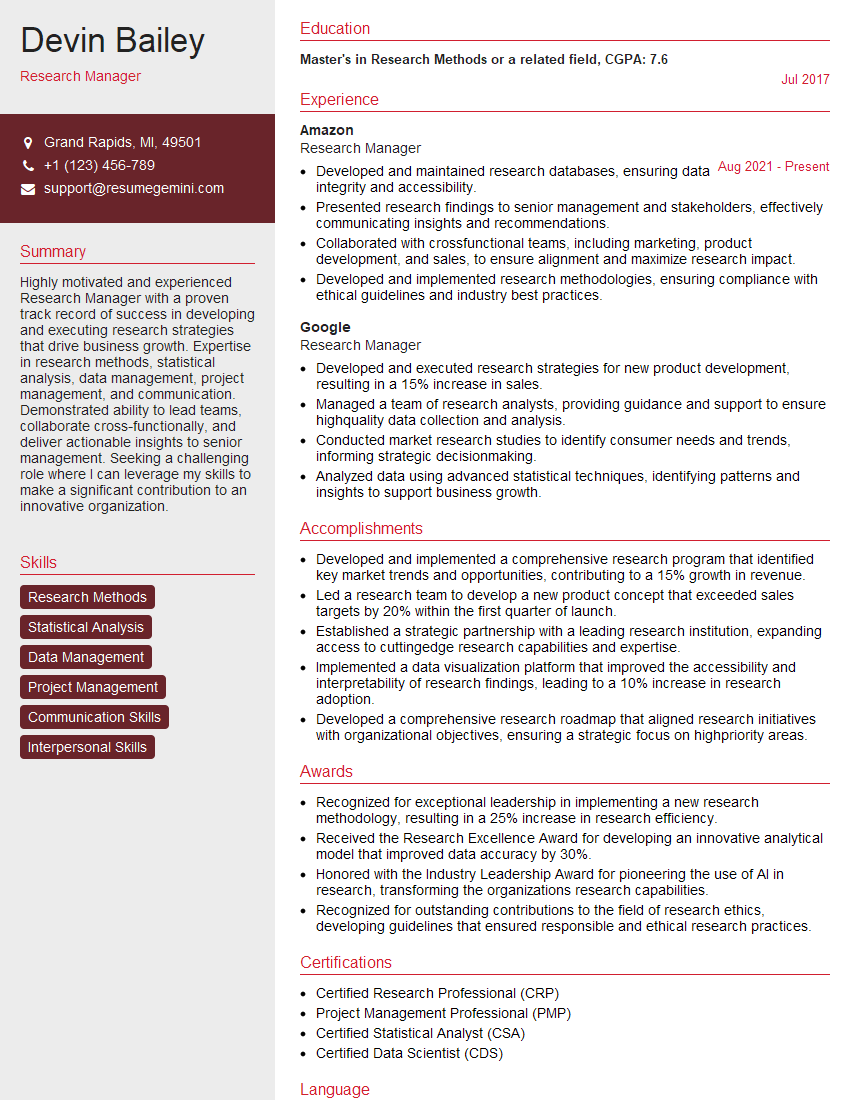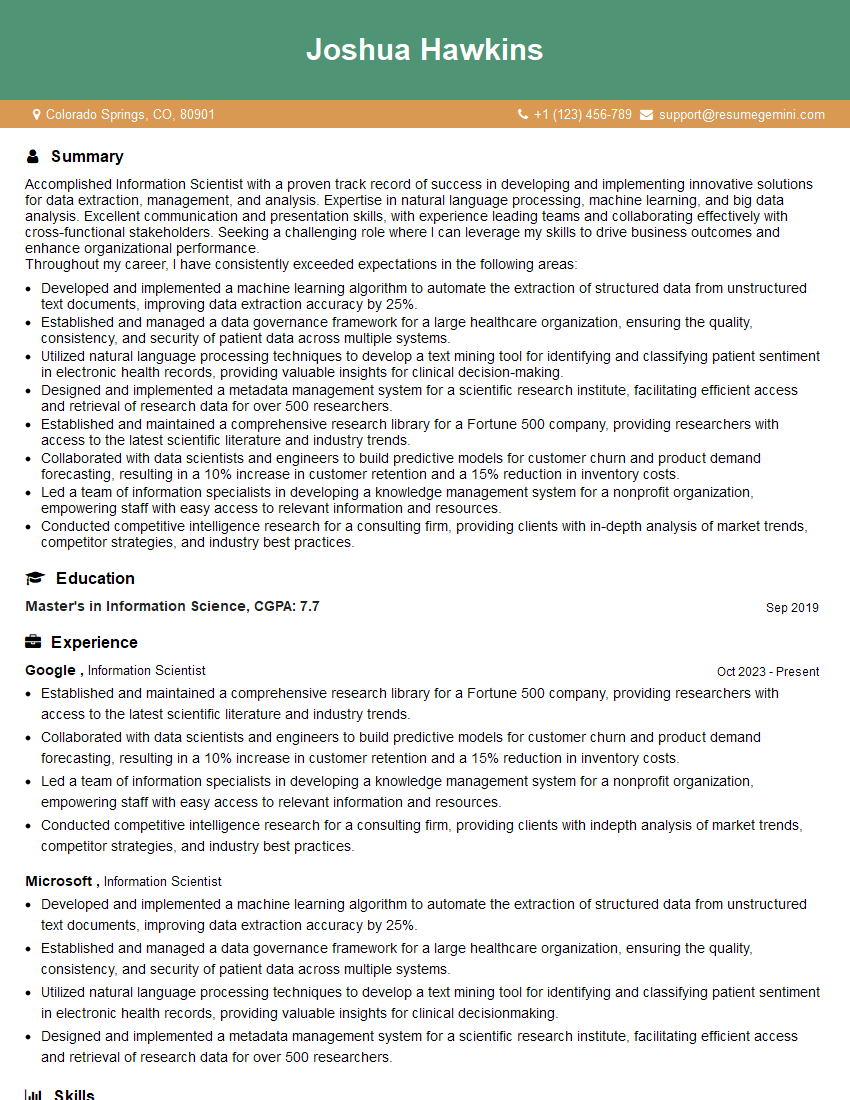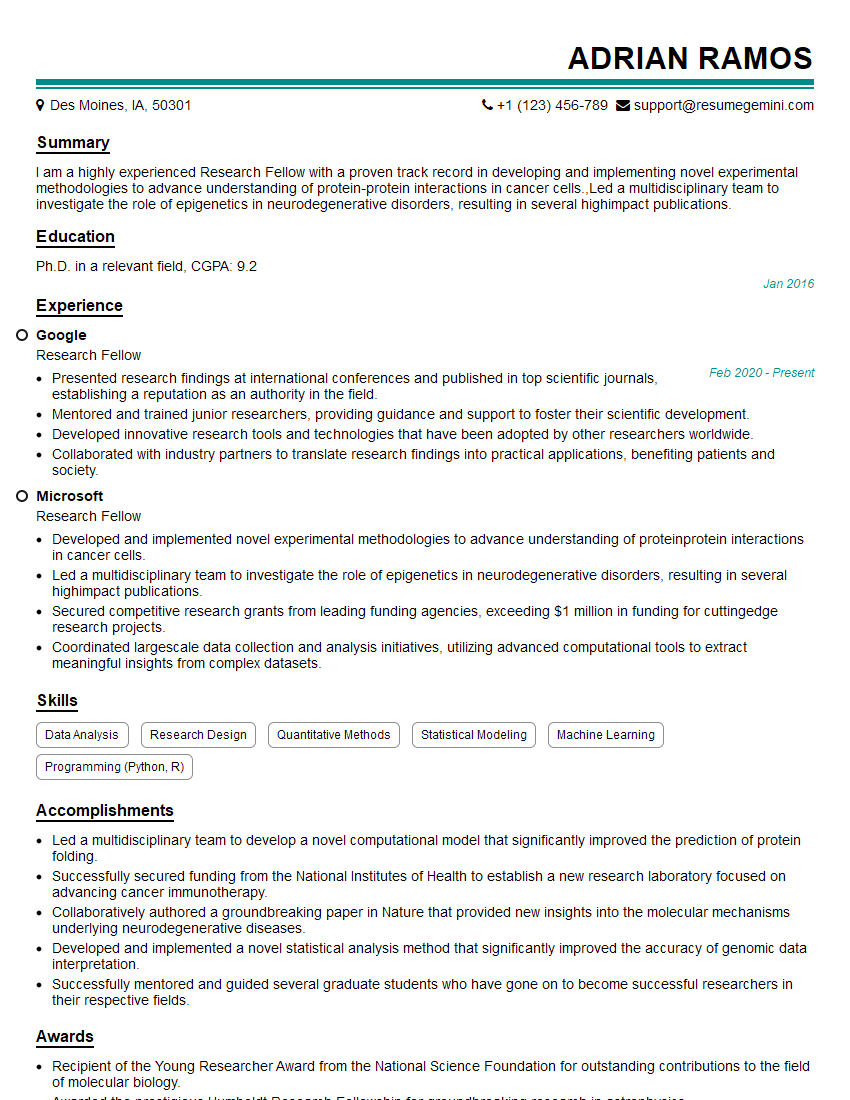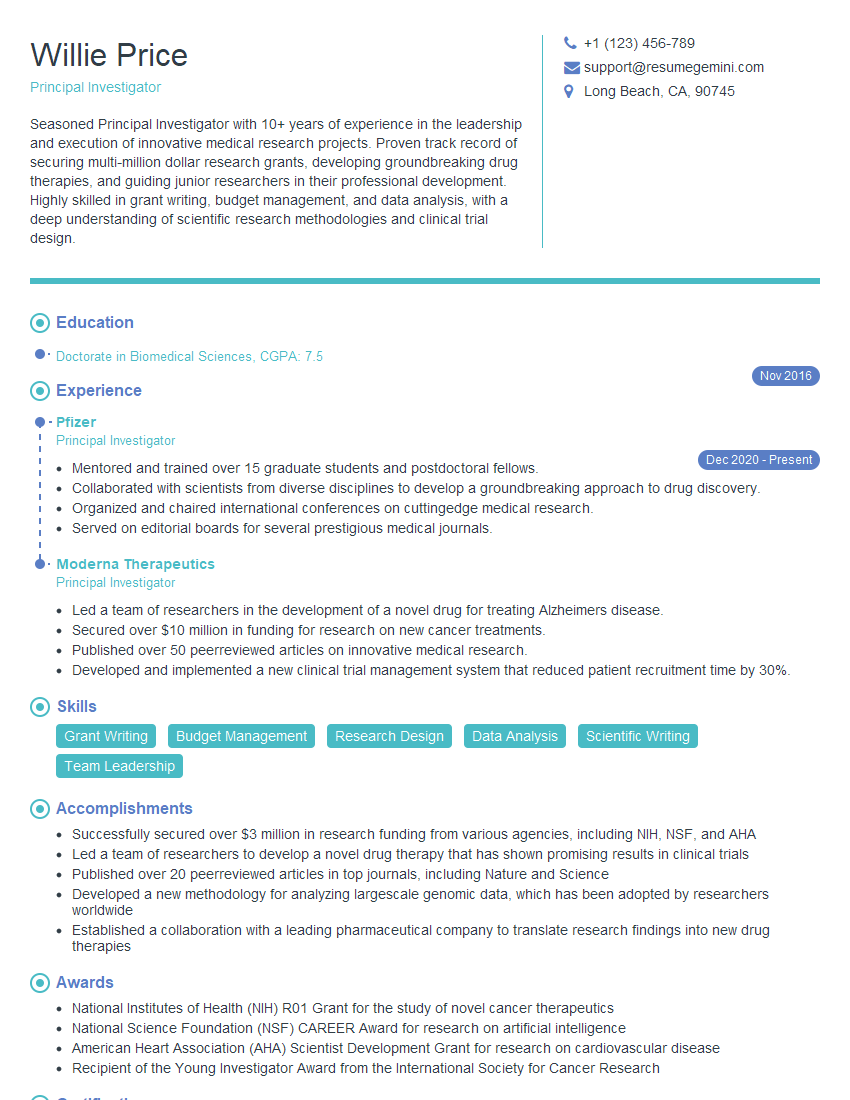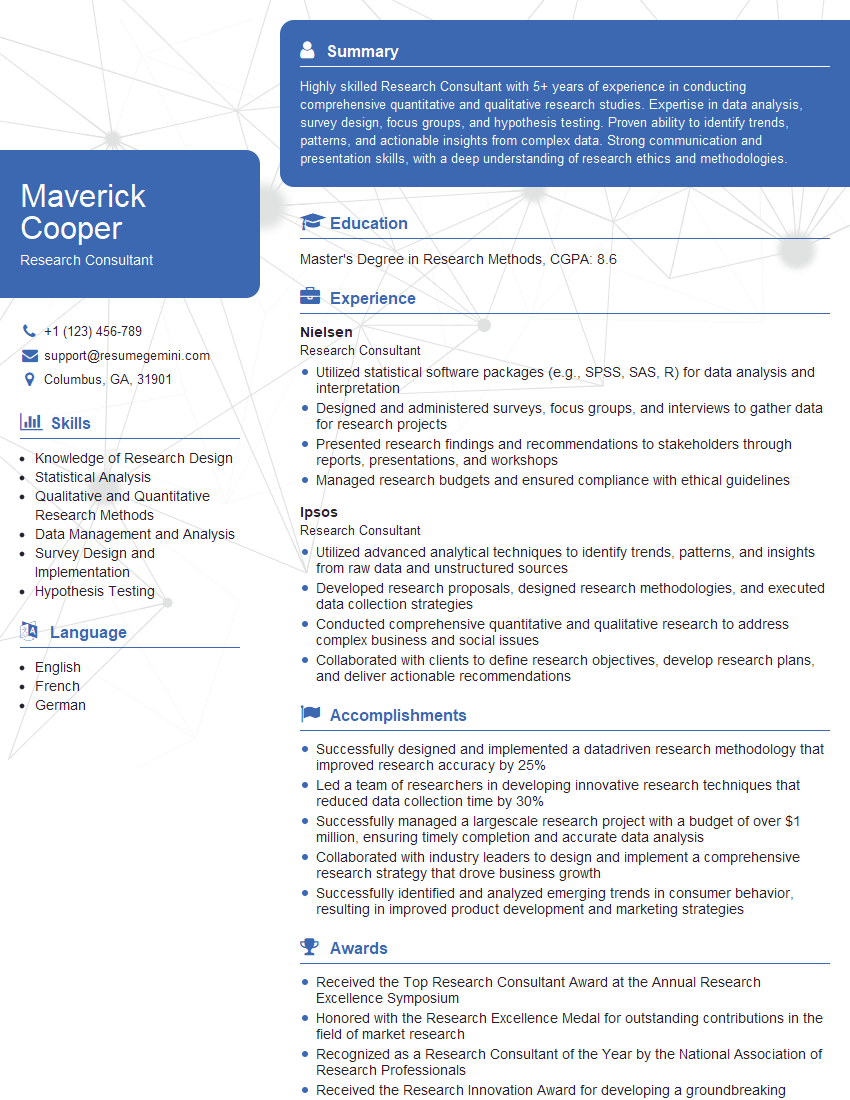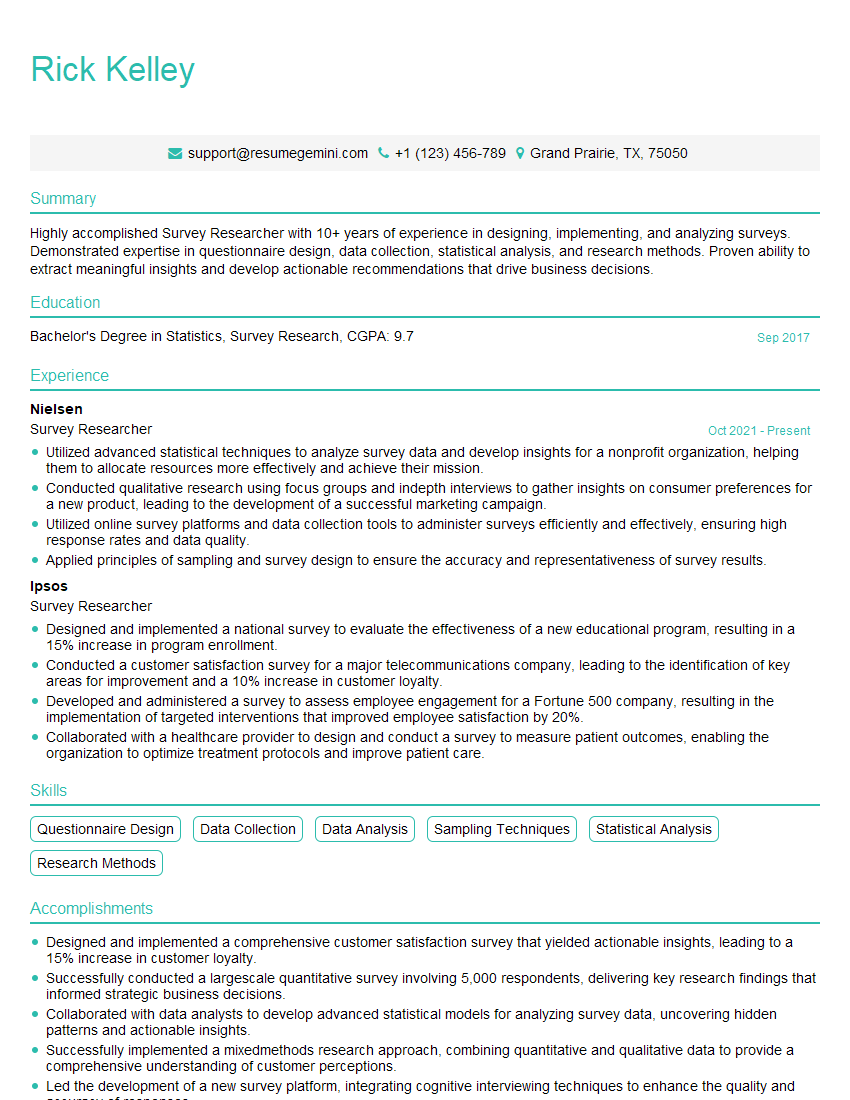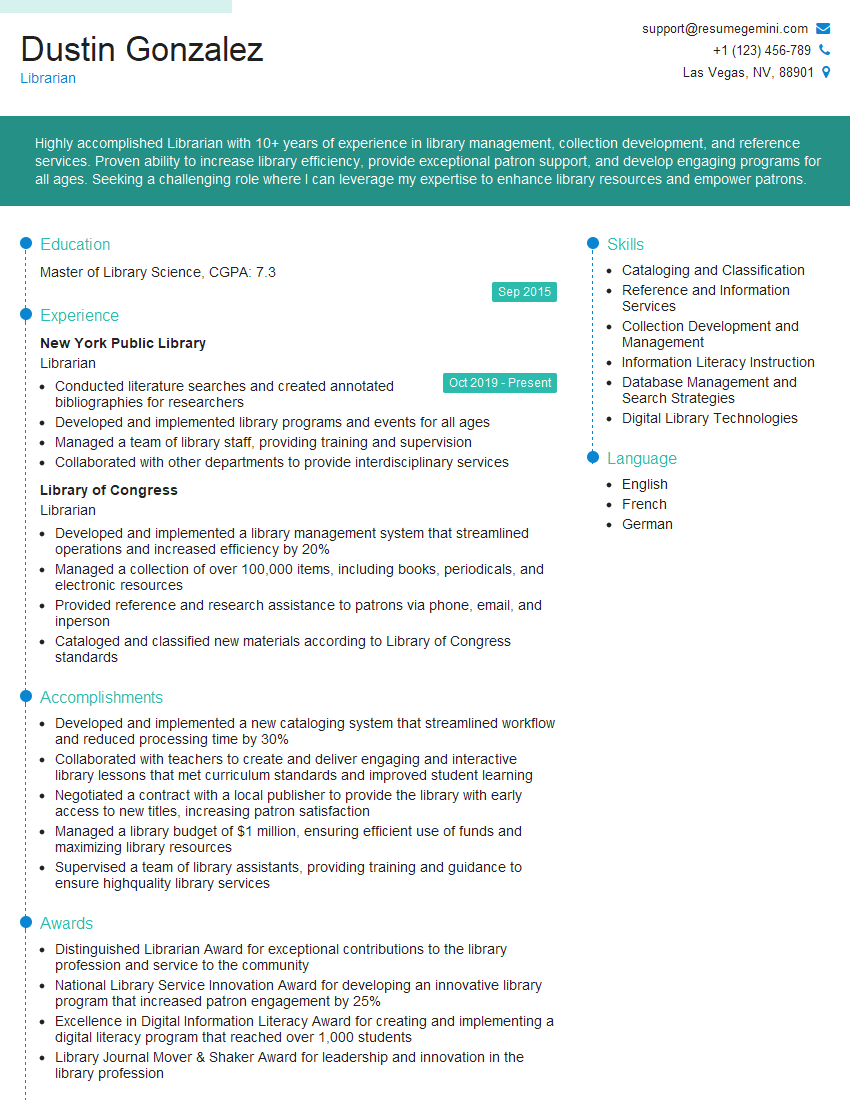Warning: search_filter(): Argument #2 ($wp_query) must be passed by reference, value given in /home/u951807797/domains/techskills.interviewgemini.com/public_html/wp-includes/class-wp-hook.php on line 324
The thought of an interview can be nerve-wracking, but the right preparation can make all the difference. Explore this comprehensive guide to Researching interview questions and gain the confidence you need to showcase your abilities and secure the role.
Questions Asked in Researching Interview
Q 1. Describe your experience with different research methodologies (qualitative, quantitative, mixed methods).
My research experience encompasses a broad spectrum of methodologies, each with its strengths and weaknesses. Qualitative research, focusing on in-depth understanding of experiences and perspectives, is invaluable for exploring complex social phenomena. For instance, I conducted a study using semi-structured interviews to understand the lived experiences of refugees adapting to a new culture. This provided rich narrative data allowing for nuanced interpretations. Quantitative research, on the other hand, leverages statistical analysis of numerical data to identify patterns and test hypotheses. A recent project involved analyzing large datasets to assess the correlation between social media usage and political polarization. Finally, mixed methods research combines both qualitative and quantitative approaches to provide a more comprehensive understanding. In one study, I used surveys (quantitative) to gather data on student satisfaction, followed by focus groups (qualitative) to explore the underlying reasons for their responses, giving a more holistic perspective.
Q 2. Explain your process for formulating a research question and hypothesis.
Formulating a strong research question and hypothesis is crucial. It begins with identifying a research gap or an interesting phenomenon. I usually start by reviewing existing literature to identify unanswered questions or areas needing further investigation. This process often involves brainstorming, discussions with colleagues, and refining the initial question. For example, if I’m interested in the effect of sleep deprivation on cognitive performance, I might initially formulate a broad question like, “How does sleep deprivation affect cognitive function?” This then needs refinement into a more focused and testable question, such as, “Does sleep deprivation of less than 6 hours negatively impact short-term memory performance in young adults?” From this refined question, I develop a testable hypothesis: “Young adults who sleep less than 6 hours will perform significantly worse on a short-term memory test compared to those who sleep 7-8 hours.”
Q 3. How do you determine the appropriate sample size for a research study?
Determining the appropriate sample size is critical for ensuring the study’s statistical power and generalizability. Several factors influence this decision, including the type of research design, the desired level of precision, the expected effect size, and the variability within the population. For instance, in a study with a large population variance, a larger sample size will be necessary to achieve a desired level of precision. There are various methods to calculate sample size, including power analysis. Software packages like G*Power or online calculators can help determine the appropriate sample size given specific parameters. If resources are limited, a pilot study can be conducted to estimate the variability within the population, enabling a more accurate sample size calculation for the main study. Ignoring this step can lead to results that are not statistically significant or representative of the population.
Q 4. What statistical software are you proficient in?
I am proficient in several statistical software packages. My primary tools include R and SPSS. R provides excellent flexibility and extensive libraries for data manipulation, statistical analysis, and visualization. I frequently use R for complex statistical modeling, including regression analyses, ANOVA, and survival analysis. SPSS, on the other hand, offers a more user-friendly interface and is particularly helpful for managing large datasets and conducting descriptive statistics. I often use SPSS for initial data exploration and generating summary statistics before moving to R for more advanced analyses. My experience with these tools extends to various statistical tests and techniques, allowing me to choose the most appropriate methods for analyzing different types of data.
Q 5. Describe your experience with data cleaning and preprocessing techniques.
Data cleaning and preprocessing are essential steps in ensuring the quality and reliability of research findings. This often involves identifying and handling missing values, outliers, and inconsistencies in the data. I typically start by examining the data for errors, such as incorrect data entry or illogical values. For example, an age value of -5 would be clearly an error. I then use various techniques to deal with missing data, such as imputation (replacing missing values with estimated values) or exclusion (removing cases with missing data). Outliers, which are data points significantly different from other data points, require careful consideration; they may indicate genuine extreme cases or data entry errors. The decision on how to handle them depends on the context and the nature of the data. Finally, I often transform variables, for example, converting categorical variables into numerical representations for certain analyses. All these steps are carefully documented to maintain transparency and reproducibility.
Q 6. How do you handle missing data in your research?
Missing data is a common challenge in research, and how it’s handled can significantly impact the results. The optimal approach depends on the amount of missing data, the pattern of missingness, and the type of data. Simple methods like listwise deletion (excluding cases with any missing values) are easy but can lead to biased results if the missing data is not random. More sophisticated techniques like imputation, including mean imputation, regression imputation, or multiple imputation, are used to fill in the missing values. Multiple imputation, in particular, is advantageous as it accounts for the uncertainty introduced by the imputation process. The choice of method is guided by the nature of the data and the potential impact on the results. The method used is always clearly documented and justified.
Q 7. Explain your understanding of different data visualization techniques.
Data visualization is essential for communicating research findings effectively. Different techniques are suited to different types of data and research questions. For example, histograms and box plots are useful for exploring the distribution of continuous variables, while bar charts and pie charts are suitable for visualizing categorical data. Scatter plots are excellent for showing the relationship between two continuous variables, and heatmaps can illustrate the correlation between multiple variables. Interactive dashboards and dynamic visualizations using tools like Tableau or Shiny (R package) are becoming increasingly important to present complex data in an engaging and easily understandable manner. The selection of visualization techniques is driven by the need for clarity and effective communication of the key findings to the intended audience. A well-chosen visualization can quickly convey insights that might be missed in a table of numbers.
Q 8. How do you ensure the validity and reliability of your research findings?
Ensuring the validity and reliability of research findings is paramount. Validity refers to the accuracy of your measurements – are you actually measuring what you intend to measure? Reliability, on the other hand, concerns the consistency of your measurements – would you get similar results if you repeated the study? I employ several strategies to bolster both.
Rigorous Study Design: A well-defined research question, appropriate methodology (e.g., randomized controlled trials for causal inferences, qualitative methods for in-depth understanding), and a clear sampling strategy are crucial. For example, in a study examining the effectiveness of a new teaching method, a randomized controlled trial would be more appropriate than a simple observational study to minimize bias and establish causality.
Pilot Studies: Before launching a full-scale study, I often conduct pilot studies to test the feasibility of the research design, refine data collection instruments (e.g., questionnaires, interview protocols), and identify potential problems.
Triangulation: Using multiple data sources (e.g., surveys, interviews, observations) and methods to investigate the same phenomenon enhances the credibility of the findings. If different approaches yield similar results, it strengthens the validity and reliability.
Statistical Analyses: Appropriate statistical tests are selected based on the research design and data type. For instance, using robust statistical methods like regression analysis helps account for confounding variables, improving the accuracy of findings. Also, reporting effect sizes alongside p-values provides a more complete picture of the results’ significance.
Peer Review: Submitting the research to peer review before publication is critical. Experts in the field scrutinize the study design, methodology, analysis, and interpretation, improving the rigor and reducing potential errors.
Q 9. Describe your experience with literature reviews and systematic reviews.
Literature reviews and systematic reviews are essential parts of my research process. A literature review broadly surveys existing research on a topic, providing context and identifying gaps in knowledge. A systematic review, on the other hand, is a more rigorous process involving a predefined search strategy, explicit inclusion/exclusion criteria, and a standardized assessment of the quality of included studies.
In my experience, I’ve conducted both types of reviews extensively. For example, I recently completed a systematic review on the effectiveness of different interventions for childhood obesity, using a predetermined search strategy across multiple databases (PubMed, Web of Science, etc.), employing quality assessment tools (e.g., Cochrane risk of bias tool), and synthesizing the findings using meta-analysis techniques. This contrasts with a literature review I previously undertook on the social determinants of health, which involved a broader exploration of relevant literature without the strict methodological constraints of a systematic review.
Q 10. How do you identify and assess bias in research?
Bias in research can severely compromise the validity of findings. I actively work to identify and mitigate various biases throughout the research process. This starts with careful consideration of the research question and study design, aiming for objectivity from the outset.
Selection Bias: This occurs when the sample is not representative of the population of interest. To minimize this, I use probability sampling techniques (e.g., random sampling, stratified sampling) whenever possible. In qualitative research, purposive sampling is used strategically, ensuring a diverse range of perspectives is included.
Measurement Bias: This relates to inaccuracies in data collection. Using standardized, validated instruments and clear operational definitions helps reduce this. For example, using a well-established depression scale instead of relying on subjective judgments.
Confirmation Bias: This is the tendency to favor information confirming pre-existing beliefs. I counter this by employing a transparent and objective analysis process, carefully considering alternative explanations, and seeking feedback from colleagues with diverse perspectives.
Publication Bias: This refers to the tendency for studies with positive results to be published more frequently than those with null or negative findings. To address this, I make efforts to consult both published and unpublished data (e.g., through grey literature searches) and utilize meta-analysis techniques which can help to assess publication bias.
Throughout the research, I maintain a detailed record of my methods and decisions, allowing for transparent scrutiny and reducing the risk of unintentional biases affecting the results.
Q 11. How do you interpret statistical results and draw meaningful conclusions?
Interpreting statistical results requires a nuanced understanding of statistical concepts and the context of the research question. I go beyond simply looking at p-values.
Effect Sizes: I focus on effect sizes, which quantify the magnitude of the relationship between variables, providing a more meaningful interpretation than p-values alone. A statistically significant result with a small effect size might not be practically relevant.
Confidence Intervals: I consider confidence intervals, which provide a range of values within which the true population parameter is likely to fall. A narrow confidence interval indicates greater precision.
Visualizations: I use graphs and charts to illustrate the data and results effectively, making it easier to understand complex relationships.
Contextual Understanding: Crucially, the statistical results are interpreted within the broader context of the research question, literature, and limitations of the study. For instance, a significant finding might need to be qualified if there were limitations in the sampling method or potential confounding variables that were not controlled for.
For example, if a study shows a statistically significant association between coffee consumption and heart disease (p<0.05), but the effect size is small and the confidence interval is wide, it suggests that the relationship is weak and not clinically significant. I would carefully consider this alongside other research and contextual factors before drawing conclusions about causality.
Q 12. Explain your experience with different data collection methods (surveys, interviews, observations).
My experience encompasses a range of data collection methods, each with its strengths and weaknesses.
Surveys: Surveys are efficient for collecting quantitative data from large samples, particularly when using online platforms. However, they can suffer from response bias and limited depth of information. I carefully design surveys to ensure clarity, minimize bias, and maximize response rates.
Interviews: Interviews provide rich qualitative data and allow for deeper exploration of complex issues. I employ different interviewing techniques (e.g., structured, semi-structured, unstructured) depending on the research question. In-depth interviews offer nuanced perspectives and valuable insights. For example, in a study exploring patients’ experiences with a new medical treatment, semi-structured interviews were crucial to fully understand their perspectives.
Observations: Observations allow for direct observation of behavior in natural settings. This can be participant observation (researcher immerses themselves in the setting) or structured observation (using predetermined coding schemes). Careful planning and training of observers are crucial to minimize observer bias. For example, in a study of classroom interactions, structured observation allows for quantitative analysis of teacher-student interactions.
The choice of method depends on the research question and resources. Often, I combine methods (mixed-methods approach) to gain a more comprehensive understanding.
Q 13. How do you manage and organize large datasets?
Managing large datasets efficiently is critical. I use a combination of software and strategies to organize and analyze data effectively.
Database Management Systems (DBMS): I leverage relational databases (e.g., MySQL, PostgreSQL) or cloud-based solutions (e.g., AWS, Google Cloud) to store and manage large datasets efficiently. This allows for efficient querying, data cleaning, and analysis.
Statistical Software Packages: I use statistical software packages (e.g., R, SPSS, STATA) to perform complex statistical analyses on large datasets. These packages offer powerful tools for data manipulation, statistical modeling, and data visualization.
Data Cleaning and Preprocessing: A significant portion of my time is dedicated to data cleaning and preprocessing, ensuring data quality and consistency. This includes handling missing data, identifying outliers, and transforming variables as needed. I meticulously document this process to ensure reproducibility.
Version Control: Using version control systems (e.g., Git) allows for tracking changes and collaborations when working with large datasets, improving reproducibility and reducing the risk of data loss.
For example, in a study analyzing social media data, I used a combination of Python scripting and SQL to extract, clean, and analyze a large dataset of tweets, organizing the data in a relational database for efficient querying and analysis. Regular backups and version control ensured data integrity.
Q 14. Describe your experience with ethical considerations in research.
Ethical considerations are paramount in research. I adhere to strict ethical guidelines throughout the research process, prioritizing the well-being and rights of participants.
Informed Consent: I obtain informed consent from all participants, ensuring they fully understand the purpose of the study, their rights, and potential risks. This process is documented carefully.
Confidentiality and Anonymity: I protect the confidentiality and anonymity of participants by using coding systems, secure data storage, and adhering to data protection regulations (e.g., GDPR).
Data Security: I implement measures to safeguard data from unauthorized access, modification, or disclosure. This involves secure data storage, access control mechanisms, and encryption where appropriate.
Institutional Review Board (IRB) Approval: I obtain IRB approval for all research involving human subjects. The IRB reviews the research protocol to ensure it meets ethical standards and protects participants’ rights.
Avoiding Conflict of Interest: I disclose any potential conflicts of interest that might influence the research process. Transparency is key.
In all my research, I prioritize the ethical treatment of participants and ensure that the research benefits outweigh any potential risks. This is non-negotiable.
Q 15. How do you communicate your research findings to different audiences?
Communicating research findings effectively hinges on tailoring the message to the audience. For a scientific audience, a peer-reviewed journal article with detailed methodology and statistical analysis is appropriate. However, for a lay audience, a more accessible format like a blog post, infographic, or even a short video might be more effective. I’ve found success in using different communication styles depending on the context.
- Academic Audiences: I present my research at conferences, publish in peer-reviewed journals, and utilize precise language and detailed methodology.
- Policy Makers: I focus on the implications of my research for policy and use clear, concise language highlighting key findings and recommendations. I might create policy briefs or presentations.
- General Public: I use simpler language, avoid jargon, and focus on the ‘so what?’ – the impact of the research on their lives. This might involve public talks, articles for popular science magazines, or social media posts.
For instance, in one project researching the impact of climate change on coastal communities, I wrote a technical report for the funding agency, presented the findings at an academic conference, and created an infographic for public dissemination.
Career Expert Tips:
- Ace those interviews! Prepare effectively by reviewing the Top 50 Most Common Interview Questions on ResumeGemini.
- Navigate your job search with confidence! Explore a wide range of Career Tips on ResumeGemini. Learn about common challenges and recommendations to overcome them.
- Craft the perfect resume! Master the Art of Resume Writing with ResumeGemini’s guide. Showcase your unique qualifications and achievements effectively.
- Don’t miss out on holiday savings! Build your dream resume with ResumeGemini’s ATS optimized templates.
Q 16. What is your experience with research project management?
My experience in research project management spans several projects, from small-scale individual studies to large-scale collaborative efforts. I’m proficient in all stages, from initial proposal development and securing funding to data collection, analysis, interpretation, and dissemination of results. I utilize project management tools like Gantt charts to visualize timelines, track progress, and manage resources effectively.
In a recent multi-year study investigating the effectiveness of a new educational intervention, I was responsible for overseeing the entire project. This included budgeting, recruitment of participants, data collection using surveys and interviews, employing statistical software for analysis (like R and SPSS), and coordinating with a team of researchers, including graduate students. We used a collaborative online platform to manage tasks, share documents, and maintain consistent communication.
Q 17. How do you prioritize competing research tasks?
Prioritizing competing research tasks requires a strategic approach. I typically use a framework combining urgency and importance. This involves categorizing tasks based on their impact and deadlines, creating a prioritized to-do list. I also use time management techniques like the Eisenhower Matrix (urgent/important), which helps to delegate, eliminate, schedule, or execute tasks effectively.
For example, I might prioritize data analysis for an impending deadline over literature review for a long-term project. Regularly reviewing and adjusting my priorities is crucial, especially when unexpected challenges arise. This involves adapting to changing circumstances and re-evaluating my to-do list accordingly.
Q 18. Describe a time you had to overcome a challenge in your research.
During a study on the effectiveness of a new drug, we encountered unexpected variability in participant responses. The initial data analysis showed inconsistent results, which challenged our initial hypotheses. We initially considered abandoning the study but instead decided to investigate the source of the variability.
Through rigorous data cleaning and additional qualitative interviews with participants, we identified several confounding variables, including medication adherence and pre-existing health conditions that we had not adequately controlled for in the study design. By incorporating these factors into our analysis and employing more sophisticated statistical techniques, we were able to produce meaningful and reliable results. This experience taught me the importance of meticulous planning, adaptability, and rigorous analysis when faced with unexpected challenges.
Q 19. What are some limitations of your preferred research method?
My preferred research method is often a mixed-methods approach, combining quantitative and qualitative data. While this provides a rich understanding of the research problem, it does have limitations. For example, large-scale quantitative surveys can be expensive and time-consuming, and the data may lack the depth of understanding offered by qualitative methods. Similarly, qualitative data (like interviews) can be subjective and difficult to generalize to larger populations.
Another limitation is the potential for researcher bias to influence the interpretation of results, particularly in qualitative studies. To mitigate these limitations, I employ rigorous methodologies, including transparent data collection and analysis procedures, appropriate sampling techniques, and triangulation of data from multiple sources to ensure validity and reliability.
Q 20. How do you stay updated on the latest research trends in your field?
Staying current with research trends is essential. I achieve this through a multi-pronged approach:
- Regularly reading peer-reviewed journals: I subscribe to several journals in my field and regularly scan their tables of contents for relevant articles.
- Attending conferences and workshops: These provide opportunities to learn about cutting-edge research and network with other researchers.
- Following key researchers and institutions on social media: This allows me to access quick updates and preprints of articles.
- Utilizing online databases and search engines: I regularly search for relevant literature using keywords and advanced search techniques on platforms like Google Scholar, PubMed, and Web of Science.
- Participating in online communities and forums: This enables me to engage in discussions with other researchers and stay informed about emerging trends.
Q 21. How do you evaluate the credibility of research sources?
Evaluating the credibility of research sources requires a critical approach. I assess several factors:
- Source Reputation: Is the research published in a reputable journal or by a respected institution?
- Peer Review: Has the research undergone rigorous peer review by experts in the field?
- Methodology: Is the research methodology clearly described and appropriate for the research question? Are the limitations of the study acknowledged?
- Data Transparency: Is the data collection and analysis process transparent and reproducible?
- Author Expertise: Are the authors recognized experts in the field?
- Potential Bias: Are there any potential conflicts of interest or biases that might affect the findings?
- Replication: Has the research been replicated by independent researchers with similar findings?
I often cross-reference information from multiple sources to ensure its accuracy and validity. It’s crucial to treat information critically, always looking for corroboration and acknowledging any potential limitations or biases.
Q 22. Describe your experience with peer review processes.
Peer review is the cornerstone of academic rigor, ensuring the quality and validity of research before publication. My experience spans several years and numerous submissions to both high-impact and specialized journals. I’ve served as both a reviewer and a recipient of reviews, which provides a comprehensive understanding of the process from both perspectives. As a reviewer, I carefully assess the methodology, data analysis, conclusions, and overall clarity of the manuscript. I provide constructive criticism focusing on areas needing improvement, including identifying potential biases, methodological flaws, and the clarity of the argument. Receiving reviews myself has taught me the importance of addressing critiques thoughtfully, improving the work’s robustness and strengthening its contribution to the field. For instance, in one instance, a reviewer’s insightful comment on a potential confounding variable prompted a significant revision of my analysis, ultimately leading to more accurate and nuanced conclusions.
This iterative process—submitting, receiving feedback, revising, and resubmitting—is crucial. It helps refine the research, enhances its impact, and ultimately advances knowledge. The process necessitates objectivity, a commitment to fairness, and a deep understanding of the subject matter.
Q 23. How do you ensure data security and confidentiality?
Data security and confidentiality are paramount in research. My approach employs a multi-layered strategy. This includes secure data storage using encrypted servers and cloud-based platforms compliant with relevant regulations like HIPAA or GDPR, depending on the data’s nature. Access to data is restricted through role-based access control, ensuring only authorized personnel can view and analyze specific datasets. Furthermore, all data is anonymized or de-identified whenever possible, removing any personally identifiable information to protect participants’ privacy. I meticulously document all data handling procedures, adhering to strict protocols for data management, version control, and audit trails, making every step transparent and traceable. For instance, in a project involving sensitive health data, we employed differential privacy techniques to further enhance confidentiality while preserving the utility of the data for analysis.
Regular security audits and training on data protection best practices are essential components of this ongoing effort. This holistic strategy minimizes the risk of data breaches and ensures compliance with ethical guidelines.
Q 24. What is your experience with using specific research databases (e.g., PubMed, JSTOR, Scopus)?
I have extensive experience navigating a variety of research databases, including PubMed, JSTOR, and Scopus. PubMed is my go-to for biomedical literature, allowing me to efficiently locate and filter relevant articles based on keywords, authors, publication dates, and other criteria. JSTOR’s vast archive provides access to historical and scholarly articles across numerous disciplines. Scopus, with its citation analysis capabilities, is invaluable for identifying highly influential papers and tracking the impact of research within specific fields. I use advanced search strategies within these databases, employing Boolean operators (AND, OR, NOT) and wildcard characters (*) to refine search results and avoid information overload. For instance, when researching the efficacy of a specific treatment, I might use a search string like "treatment X" AND ("clinical trial" OR "meta-analysis") AND "adult population" in PubMed to focus my search effectively.
Understanding the nuances of each database’s indexing and search functionality is crucial for effective research. My expertise ensures I find the most relevant, high-quality information efficiently.
Q 25. Explain your understanding of different types of research designs (experimental, correlational, descriptive).
Research designs are the blueprints for how research is conducted, each serving a different purpose.
- Experimental designs involve manipulating an independent variable to observe its effect on a dependent variable. This approach allows for causal inference, establishing that changes in the independent variable directly cause changes in the dependent variable. A classic example is a randomized controlled trial (RCT) comparing a new drug’s effectiveness against a placebo.
- Correlational designs examine the relationship between two or more variables without manipulating any of them. These studies identify associations but cannot establish causality. For instance, a study might explore the correlation between hours of exercise and stress levels.
- Descriptive designs aim to describe the characteristics of a population or phenomenon without investigating relationships between variables. These might include case studies, observational studies, or surveys. An example is a study describing the prevalence of a particular disease in a specific community.
Choosing the appropriate design depends on the research question and the feasibility of different approaches. Understanding their strengths and limitations is vital for conducting rigorous and meaningful research.
Q 26. How do you handle conflicting research findings?
Conflicting research findings are common in scientific inquiry. Handling these situations requires a critical and systematic approach. First, I carefully examine the methodologies employed in each study, looking for potential sources of discrepancies such as sample size, participant characteristics, measurement tools, or analysis techniques. I then consider the quality of the evidence presented and the robustness of the conclusions drawn. Publication bias should also be considered – negative or non-significant results might be under-represented in the literature.
If the conflict persists, meta-analysis or systematic review may be warranted to synthesize the existing evidence and assess the overall effect size. A narrative review summarizing the findings and identifying areas of agreement and disagreement can also be useful. Ultimately, I acknowledge the limitations of each study and interpret the findings within the context of the available evidence, highlighting the need for future research to resolve the inconsistencies.
Q 27. Describe a time you had to revise your research methodology.
During a study investigating the impact of social media on adolescent mental health, our initial plan was to use a cross-sectional survey design. However, preliminary data revealed limitations with self-reporting biases and a lack of longitudinal perspective on the evolving relationship. Recognizing these shortcomings, we revised our methodology to incorporate a mixed-methods approach.
We augmented the survey with qualitative interviews to gather richer, contextualized information, exploring the experiences of adolescents in greater depth. We also implemented a longitudinal component, tracking the same participants over a year to observe changes in mental health alongside their social media use. This revision significantly improved the study’s depth and validity, providing a more nuanced understanding of the complex interplay between social media and adolescent wellbeing. The revised methodology yielded far richer and more reliable results than initially anticipated, effectively addressing the identified limitations.
Q 28. How do you ensure the generalizability of your research findings?
Generalizability, or external validity, refers to the extent to which research findings can be applied to populations beyond the specific sample studied. Ensuring generalizability is crucial for the broader impact of research. This is achieved through several strategies:
- Representative sampling: Employing a sample that accurately reflects the characteristics of the target population is vital. Techniques like random sampling, stratified sampling, or cluster sampling can help achieve this.
- Large sample size: Larger samples provide more precise estimates and reduce the influence of sampling error, making the findings more generalizable.
- Replicating the study: Repeating the study with different samples and in different settings can demonstrate the robustness of the findings and their applicability across diverse contexts.
- Careful consideration of contextual factors: Acknowledging and addressing potential contextual factors that might influence the results is crucial for determining the boundaries of generalizability.
For instance, a study conducted on a particular age group might not be directly generalizable to other age groups. Clearly defining the limitations of the study and the target population helps to avoid unwarranted generalizations, ensuring responsible interpretation of the results.
Key Topics to Learn for a Researching Interview
- Research Methodology: Understanding qualitative and quantitative research methods, their strengths and weaknesses, and appropriate application in different contexts. Consider exploring specific methodologies like ethnography, experimental design, or statistical analysis.
- Data Analysis & Interpretation: Proficiency in analyzing data from various sources, drawing meaningful conclusions, and presenting findings effectively using visualizations and reports. Practice interpreting complex datasets and identifying patterns.
- Literature Review & Synthesis: Demonstrating the ability to critically evaluate existing research, synthesize findings, and identify gaps in knowledge. Practice summarizing key arguments and identifying connections between disparate research papers.
- Research Design & Planning: Understanding the process of designing research projects, including formulating research questions, defining variables, and selecting appropriate sampling methods. Consider exploring different research designs (e.g., longitudinal, cross-sectional).
- Ethical Considerations in Research: Familiarity with ethical principles in research, including informed consent, data privacy, and responsible data handling. This is crucial for demonstrating integrity and professionalism.
- Communication & Presentation Skills: Ability to clearly and concisely communicate research findings to both technical and non-technical audiences, both verbally and in writing. Practice presenting your work in a clear and engaging manner.
- Problem-Solving & Critical Thinking: Demonstrating the ability to identify research problems, develop solutions, and critically evaluate the implications of research findings. Practice applying your knowledge to solve realistic research challenges.
Next Steps
Mastering researching skills is crucial for career advancement in many fields, opening doors to exciting opportunities and intellectual stimulation. A strong foundation in research methodologies and analytical skills will make you a highly valuable asset in any organization. To maximize your job prospects, create an ATS-friendly resume that highlights your research experience and accomplishments. ResumeGemini is a trusted resource to help you build a professional and impactful resume, ensuring your skills and experience shine. Examples of resumes tailored to Researching positions are available to guide you.
Explore more articles
Users Rating of Our Blogs
Share Your Experience
We value your feedback! Please rate our content and share your thoughts (optional).
What Readers Say About Our Blog
Hi, I represent a social media marketing agency that creates 15 engaging posts per month for businesses like yours. Our clients typically see a 40-60% increase in followers and engagement for just $199/month. Would you be interested?”
Hi, I represent an SEO company that specialises in getting you AI citations and higher rankings on Google. I’d like to offer you a 100% free SEO audit for your website. Would you be interested?
